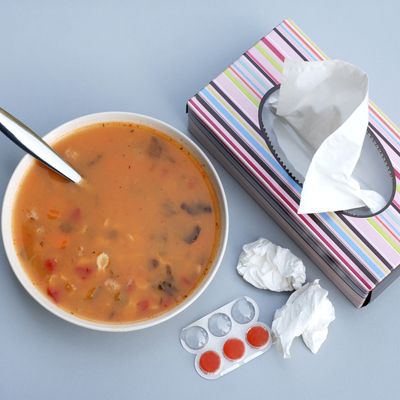
If there’s one good thing about coming down with a cold, it’s the freedom to live by the age-old maxim “feed a cold, starve a fever.” Sure, your sense of taste might be dulled by your congested nose, but that’s all the more reason to order your favorite spicy takeout and sink into the couch for a day of self-pity and reality television, right? … Right?
Maybe you’ve made it well into adulthood without ever questioning where, exactly, this phrase comes from (besides your parents or the school nurse), or how accurate it is. If so, join the club. Let’s get to the bottom of it.
Where does this rule come from?
According to Fact or Fiction 2: 50 (More) Popular Myths Explained by the editors of Scientific American, this phrase can be traced all the way back to a dictionary by John Withals from 1574 (!). Withals wrote that “fasting is a great remedy of fever,” based on the belief that food warms the body when sick with a “cold,” and avoiding food could therefore help cool it down.
Is “feed a cold, starve a fever” true?
It’s about half true. Modern science dictates that the truest maxim is even better: feed a cold, feed a fever. When your body is sick (whether with cold, fever, or flu), it needs energy to fight off infection. Fever is a response to infection, and because it raises body temperature, it burns more calories, so it’s important to keep taking them in. This is not to say that either cold or fever require you to eat any more than usual; overstuffing oneself won’t really add anything to your attempts to recover (though the pizza might taste nice). And it’s common to experience a loss of appetite while sick; William Schaffner, chair of the Department of Preventive Medicine at Vanderbilt University School of Medicine, told Scientific American that there’s no need to force-feed yourself if you don’t feel like eating.
That said, you do need to force yourself to hydrate. Sometimes people are good about drinking extra liquids when they first get sick, but then make the mistake of easing up at the first sign of improvement. It sounds gross, but staying hydrated keeps our mucus thin enough to run through (and out of) the body, which is essential to recovery. That means drinking lots of water while avoiding alcohol and caffeine, both of which are dehydrating.
What should I eat when I have a cold (or a fever)?
Chicken soup is another cold cliché, and though it’s not exactly a magic cure, soup in general is a good sick-meal choice because it provides both calories and hydrating broth. Some other recommendations include antioxidant- and vitamin C–rich fruits and vegetables, like spinach, cantaloupe, peaches, kale, and tomatoes. Vitamin E foods might also be helpful; those include peanut butter, almonds, and sunflower seeds. It’s also okay, though, to just eat what you’re hungry for. All calories provide energy, and that’s what’s most needed here — plus, again, liquids: water, caffeine-free tea, juice, and soup.





